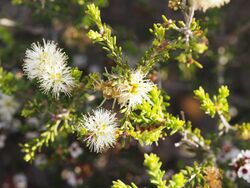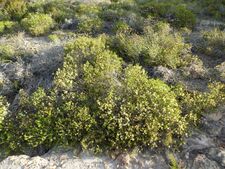Biology:Melaleuca bracteosa
| Melaleuca bracteosa | |
|---|---|

| |
| Scientific classification | |
| Kingdom: | Plantae |
| Clade: | Tracheophytes |
| Clade: | Angiosperms |
| Clade: | Eudicots |
| Clade: | Rosids |
| Order: | Myrtales |
| Family: | Myrtaceae |
| Genus: | Melaleuca |
| Species: | M. bracteosa
|
| Binomial name | |
| Melaleuca bracteosa Turcz.[1]
| |
Melaleuca bracteosa is a low, spreading shrub in the myrtle family, Myrtaceae and is endemic to the south-west of Western Australia. It has tiny, fleshy, non-prickly leaves and cream flowerheads.
Description
Melaleuca bracteosa is sometimes an erect shrub to a height of 1.5 metres (5 ft) but is more usually a low, dense spreading shrub to about 0.5 m (2 ft). Its leaves are narrow oval in shape, 2.7–9 mm (0.1–0.4 in) long and 0.9–1.5 mm (0.04–0.06 in), glabrous, bright green and fleshy with a blunt tip.
The flowers are usually bright cream coloured but sometimes white or mauve-pink. They are in heads, sometimes on the ends of branches and sometimes on the sides of the stem, each head about 16 mm (0.6 in) in diameter and containing 5 to 20 individual flowers. The stamens are arranged in five bundles around the flower, each bundle containing 3 to 8 stamens. The flowering season lasts from August to November and is followed by fruit which are woody capsules 2.4–3.2 mm (0.09–0.1 in) long.[2][3]
Taxonomy and naming
This species was first formally described in 1847 by the Russian botanist Nikolai Turczaninow in Bulletin de la classe physico-mathematique de l'Academie Imperiale des sciences de Saint-Petersburg.[4][5] The specific epithet (bracteosa) is from the Latin bractea, meaning bract, referring to the persistent bracts of the flowers.[3]
Distribution and habitat
This melaleuca occurs from the Pingrup district south to Albany and east to Ravensthorpe in the Avon Wheatbelt, Esperance Plains, Jarrah Forest and Mallee biogeographic regions.[6] It grows in sand, loam or clay on winter-wet flats or plains[7] often under low trees or tall shrubs.[2]
Conservation status
Melaleuca bracteosa is classified as "not threatened" by the Government of Western Australia Department of Parks and Wildlife.[6]
Uses
Essential oils
This species produces sesquiterpene oils at a rate of 0.3% (weight for weight) from fresh leaves.[3]
References
- ↑ "Melaleuca bracteosa". https://biodiversity.org.au/nsl/services/apc-format/display/88496. Retrieved 3 October 2019.
- ↑ 2.0 2.1 Holliday, Ivan (2004). Melaleucas : a field and garden guide (2nd ed.). Frenchs Forest, N.S.W.: Reed New Holland Publishers. pp. 32–33. ISBN 1876334983.
- ↑ 3.0 3.1 3.2 Brophy, Joseph J.; Craven, Lyndley A.; Doran, John C. (2013). Melaleucas : their botany, essential oils and uses. Canberra: Australian Centre for International Agricultural Research. p. 96. ISBN 9781922137517.
- ↑ "Melaleuca bracteosa". APNI. https://id.biodiversity.org.au/instance/apni/509174. Retrieved 11 March 2015.
- ↑ Turczaninow, Nikolai (1852). Bulletin de la classe physico-mathematique de l'Academie Imperiale des sciences de Saint-Petersburg, Volumes 10-11. St. Petersburg. p. 340. https://books.google.com/books?id=qSAYAAAAYAAJ&q=melaleuca+laxiflora&pg=PA191. Retrieved 15 March 2015.
- ↑ 6.0 6.1 "Melaleuca bracteosa". FloraBase. Western Australian Government Department of Parks and Wildlife. https://florabase.dpaw.wa.gov.au/browse/profile/5880.
- ↑ Paczkowska, Grazyna; Chapman, Alex R. (2000). The Western Australian flora : a descriptive catalogue. Perth: Wildflower Society of Western Australia. p. 392. ISBN 0646402439.
Wikidata ☰ Q15370037 entry
 |



